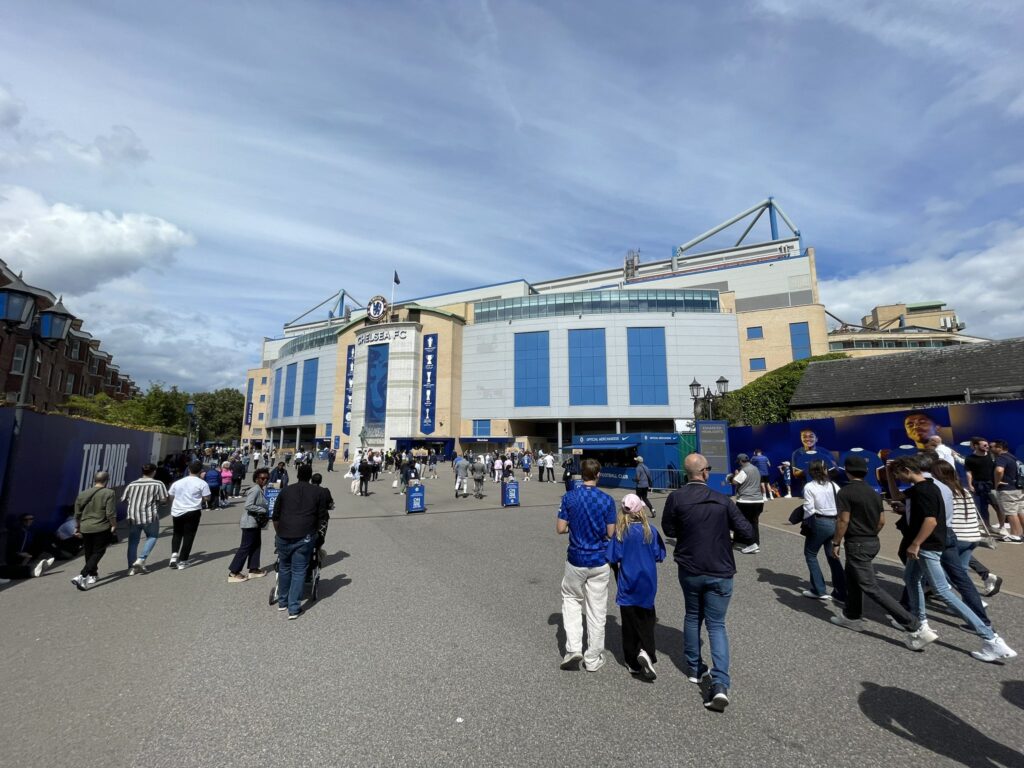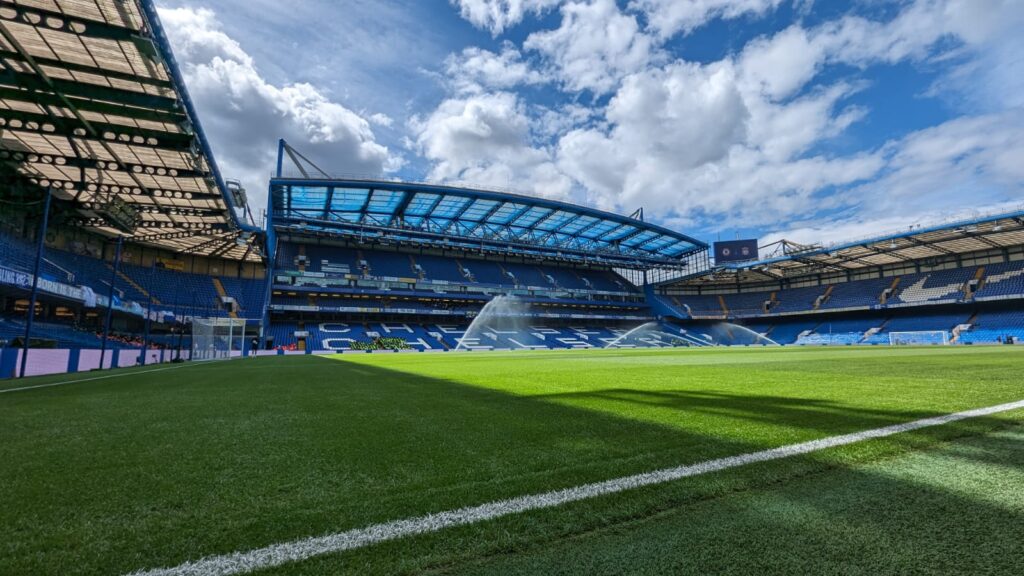
A revered temple of football, Stamford Bridge holds more than a century of pulsating history, exhilarating games, and unforgettable moments.
Each corner of Stamford Bridge, every blade of grass on that hallowed pitch, has a story to tell. Stories of spectacular goals, heart-stopping saves, and nerve-wracking penalty shootouts.
Brief history of Stamford Bridge
Perched on the banks of the River Thames, Stamford Bridge has been the heart and soul of Chelsea Football Club since its inception in 1905. But the story of this iconic sporting arena goes way beyond the Blues, blending rich history with unforgettable sporting moments.
The Early Days:
Stamford Bridge was originally opened in 1877 as an athletics stadium. It was a marvel of its time, with its cycling track and cinder running track. However, in 1904, it was due for a redesign.
The Transformation:
Businessman Gus Mears acquired Stamford Bridge with the grand vision of transforming it into a football ground. Architect Archibald Leitch famed for his work on numerous football stadiums, was tasked with the redesign.
The result was a stadium that could hold an impressive 100,000 spectators, making it one of the largest stadiums of its time.
“I saw the potential of this place. It could hold thousands, and with some minor changes, it could be a great football ground.” – Gus Mears
The Birth of Chelsea:
With the newly transformed Stamford Bridge ready, Mears attempted to lease it to an existing football club. However, when his efforts met with no success, he decided to form a new club, and thus, Chelsea Football Club was born.
The Stamford Bridge We Know Today
Over the years, Stamford Bridge has undergone several changes. In the late 20th century, the club embarked on a massive renovation initiative to modernize the facilities.
Now, Stamford Bridge boasts a seating capacity of over 40,000, state-of-the-art facilities, and a reputation as one of the most iconic football stadiums in the world.
The early days of Chelsea Football Club
The early days of Chelsea Football Club were marked by both excitement and struggle. The club was admitted to the Football League shortly after its establishment, but success did not come easy. The Blues, as they came to be known, faced fierce competition and grappled with fluctuating performance.
The First Match
The first competitive match played by Chelsea Football Club was on September 2, 1905, against Stockport County. The Blues emerged victorious, setting the tone for a club that would become synonymous with resilience and determination.
| Date | Opponent | Result |
|---|---|---|
| September 2, 1905 | Stockport County | Win |
As the club navigated the highs and lows of its early years, one thing remained constant: the unwavering spirit of its players and supporters. Their passion for the sport and for their club set the foundation for the Chelsea Football Club we know and love today.
The transformation of Stamford Bridge
Stamford Bridge, the iconic home of Chelsea Football Club, has undergone a remarkable transformation since its inception. Let’s embark on a journey that will take us through the fascinating evolution of this world-renowned football stadium.
Early Foundations
Originally a famous athletics venue, Stamford Bridge opened its doors in 1877. It was not until 1905 that it became the home of the newly-formed Chelsea Football Club. The initial structure, designed by renowned Scottish architect Archibald Leitch, featured a single covered stand and open terracing on the remaining three sides.
The 1930s Makeover
In the 1930s, Stamford Bridge underwent one of its most significant transformations. The terracing was replaced with concrete stands, increasing the stadium’s capacity and laying the groundwork for what Stamford Bridge would eventually become.
Post-War Developments
After enduring the devastation of World War II, the stadium saw another wave of improvements. The famous Shed End was erected in 1965, reflecting the fashionable architectural trends of the time. This new addition helped solidify the stadium’s iconic status.
Modern Era Revamp

The turning point in Stamford Bridge’s transformation came in the 1990s. Challenged by new safety regulations following the Hillsborough disaster, the club made a bold decision to completely revamp the stadium. This led to the construction of the current all-seater stadium, with a capacity of approximately 41,000 spectators.
The impact of War on World II Stamford Bridge
As the dark clouds of World War II loomed over the world, Stamford Bridge was not untouched by its profound impact. This iconic stadium, home to Chelsea Football Club, experienced significant changes during this turbulent period.
The Stadium’s Transformation
The onset of the war saw Stamford Bridge transformed from a football stadium into an air-raid shelter. The vast terraces, once teeming with enthusiastic fans, were soon filled with frightened civilians seeking refuge from the relentless bombing raids.
Stamford Bridge’s vast terraces, once alive with the cheers of football fans, now echoed with the fear of the London populace seeking refuge from the horrors of air raids.
The Suspension of Football Matches
With the declaration of war in 1939, the Football League was immediately suspended. Stamford Bridge, which had been a pulsating hub of football activity, fell eerily silent.
All official matches were put on hold, and in their place, regional matches with limited audiences were organized.
A Symbol of Resilience
Despite the catastrophic impact of the war, Stamford Bridge emerged as a symbol of resilience. Even amidst danger and destruction, football continued to be played at the Bridge. Makeshift games were organized, serving as a beacon of hope and a testament to the indomitable spirit of the people.
Post-war Recovery
As the war ended, Stamford Bridge, like the rest of the country, embarked on a journey of recovery. The stadium was renovated, and the Football League resumed. In 1945, Stamford Bridge witnessed its first post-war match, marking a significant milestone in its history.
Through the ravages of World War II, Stamford Bridge stood as a testament to the tenacity and resilience of the human spirit. Its story is a compelling chapter in the annals of football history.
The dark days of Stamford Bridge
Delving into the annals of Stamford Bridge’s storied past, it is quite clear that its journey towards becoming the revered cathedral of football it is today was riddled with trials and tribulations. From financial troubles to the brink of relegation, the Bridge has weathered it all, emerging stronger and more resilient at every turn.
The Financial Turmoil
Like a ship caught in a violent storm, Stamford Bridge found itself in a precarious financial predicament during the early 1980s. The club had plunged into debt, a situation exacerbated by dwindling match attendance and a lack of significant investment.
“It was a time of uncertainty, a time when the very existence of the club was hanging by a thread. Yet, the dedication and passion of the fans never wavered,” a long-time Chelsea supporter recalls.
The Brink of Relegation
The club’s financial woes ushered in a period of sporting decline. The 1987-88 season stands out as one of the darkest in Stamford Bridge’s history. The club was teetering on the edge of relegation, with performances on the pitch mirroring the turmoil off it.
Despite the dire circumstances, the team rallied, displaying a fighting spirit that would become a cornerstone of the club’s identity. The Bridge was no stranger to adversity, and this period served to galvanize the players, staff, and fans alike.
The Silver Lining
While these were undoubtedly dark days, they were also instrumental in shaping the club’s future. The trials and tribulations forced a radical rethink of the club’s strategy, prompting significant changes in management and the adoption of a more sustainable financial model.
Furthermore, this era saw the rise of several young talents who would go on to become stalwarts at the club, proving that even in the darkest hours, there were glimmers of hope.
The golden era of Chelsea FC
Indeed, a golden era it was. A period spanning across decades of scintillating matches, captivating moments, and powerhouse performances.
The time when Chelsea FC truly etched its name in gold letters in the annals of football history. Let’s journey back into the heart of that era, where every match was a spectacle, every victory a celebration.
The Dawn of the Golden Era
It all began in the early 2000s, as Chelsea FC was ushered into an era of unprecedented success and fame under the ownership of Roman Abramovich.
The Russian billionaire’s takeover in 2003 marked a turning point in the club’s fortune, and Chelsea FC was once again on the ascendant.
“Football is a game of passion and of love. It’s about dreams. And Chelsea is a place where dreams come true.” – Roman Abramovich
A New Chapter of Success
Under the guidance of José Mourinho, Chelsea FC achieved a level of success that was hitherto unparalleled in the club’s history.
Mourinho’s appointment in 2004 marked the beginning of a new chapter of success for Chelsea FC, as the Blues went on to win two consecutive Premier League titles in 2005 and 2006.
The Mourinho Impact
The Portuguese manager’s impact was palpable from the start. He instilled a winning mentality and a killer instinct into the squad, transforming Chelsea into a formidable force that was feared across Europe.

Mourinho’s tactical acumen, coupled with the performances of players like Frank Lampard, John Terry, and Didier Drogba, made Chelsea FC practically invincible. It was during these years that Stamford Bridge became a fortress, a venue where opposing teams dreaded to set foot.
The Legacy Continues
The golden era of Chelsea FC was not just confined to the Mourinho years. Even after his departure, the club continued to taste success under various managers.
Chelsea FC added more silverware to their collection, including the coveted UEFA Champions League trophy in 2012, further cementing their status as one of the top clubs in world football.
What is the capacity of Stamford Bridge?
The current capacity of Stamford Bridge stands at an impressive 41,837. While the capacity of Stamford Bridge is certainly substantial, it’s worth noting that it wasn’t always this large.
The stadium has gone through several expansions since it first opened its doors. Here’s a snapshot of its capacity growth:
| Year | Capacity |
|---|---|
| 1877 | 100 |
| 1905 | 40,000 |
| 1930 | 82,905 |
| 1994 | 34,500 |
| Present | 41,837 |
The reduction in capacity in 1994 was due to the implementation of the Taylor Report, which called for all major stadiums in the UK to become all-seater. This change greatly improved safety but decreased the number of spectators that could be accommodated.
What are some famous matches that have taken place at Stamford Bridge?
Stamford Bridge, the home of Chelsea Football Club, has been a cauldron of high stakes football since it’s inauguration in 1877. This revered stadium has been the stage for countless intense matches, serving as the backdrop to moments of ecstasy, drama, and heartbreak.
Here we delve into some of the most famous matches that have taken place at Stamford Bridge:
Chelsea vs. Liverpool (Champions League Semi-finals, 2008)
A game that is forever etched in the annals of Stamford Bridge history, the Champions League semi-final second leg between Chelsea and Liverpool in 2008 was one for the ages. The game finished 4-4 after extra time, but Chelsea advanced to the final on aggregate.
Chelsea vs. Napoli (Champions League Round of 16, 2012)
In a nerve-wracking encounter with Napoli in 2012, Chelsea overcame a two-goal deficit from the first leg to triumph 4-1 in the second leg at Stamford Bridge.
This match, marked by high drama and exceptional football, was a turning point in Chelsea’s Champions League campaign, culminating in them lifting the trophy later that year.
Chelsea vs. Manchester United (Premier League, 2004)
The 2004 encounter between Chelsea and Manchester United stands as a classic example of Premier League football at its best.
Chelsea triumphed with a 1-0 victory, courtesy of a solitary goal from Joe Cole. This match is often remembered as the one that solidified Jose Mourinho’s Chelsea as serious title contenders.
These are but a few of the countless memorable matches that have taken place at this storied stadium. Each of these games represents a chapter in the rich tapestry of Stamford Bridge’s history.
What is the atmosphere like at Stamford Bridge during a match?
Welcome to the experience of a match day at Stamford Bridge. The atmosphere is nothing short of thrilling, every moment charged with raw emotion and the passionate support of the fans.
The Energy of the Crowd
The heartbeat of Stamford Bridge is its ardent supporters. Dressed in Chelsea blue, they fill the stands, their chants and cheers creating a wall of sound that reverberates throughout the venue. The camaraderie among the fans is palpable, building an atmosphere of unity and shared excitement.
“The fans here are incredible. They create a vibrant, pulsating atmosphere that truly ignites every match.” – A regular Stamford Bridge attendee
The Magic of the Pitch
Nothing compares to the spectacle unfolding on the pitch, the players becoming larger than life. Each move, each goal, each save intensifies the atmosphere, escalating the tension and igniting the crowd with every twist and turn of the match.
Celebrating Victory
And when Chelsea scores, the roar that erupts from the stands is deafening, the joyous celebration a testament to the profound love the fans have for their team. It is a moment of pure, unadulterated euphoria that encapsulates the spirit of Stamford Bridge.
In sum, the atmosphere at Stamford Bridge during a match is an intoxicating blend of passion, anticipation, and camaraderie, an experience that is truly beyond compare.
What are some interesting facts about Stamford Bridge?
Known as the home of the Blues, Stamford Bridge is a football stadium teeming with thrilling facts and fascinating history.
The Origins of Stamford Bridge
Here are some intriguing facts about Stamford Bridge’s early days:
- The stadium was officially opened on 28th April 1877. However, it wasn’t until 1905 that it became the home of Chelsea Football Club.
- Stamford Bridge was originally a sporting complex, hosting both athletics and football matches. It even had a running track around the pitch until the early 1900s.
- Despite its name, Stamford Bridge is not situated in Stamford Bridge, a village in East Riding of Yorkshire. It’s actually in Fulham, positioned exactly between the affluent Chelsea and Fulham districts.
Architectural Triumph
Stamford Bridge’s architectural evolution is a testament to the club’s growth and success. Here’s how it developed over the years:
- At its inception, the stadium’s capacity was a staggering 100,000. At the time, it was second only to Crystal Palace in terms of capacity, making it one of the biggest stadiums in the country.
- In 1930, the construction of a new, modern stand reduced the stadium’s capacity. However, it introduced a notable feature – the iconic Shed End, which became synonymous with the stadium.
- The stadium underwent a major renovation in the 1990s, transforming it into a state-of-the-art, all-seater venue. Its current capacity stands at approximately 41,000.
Historic Moments
Stamford Bridge has witnessed countless memorable moments. These are but a few:
- In 1970, the stadium hosted the FA Cup final replay between Chelsea and Leeds United, which Chelsea won in a thrilling contest.
- Stamford Bridge was witness to Chelsea’s first Premier League title win in 50 years in 2005 under the management of Jose Mourinho.
- The Champions League semi-final in 2009, between Chelsea and Barcelona, is considered one of the most dramatic games in the stadium’s history.
What is the process of getting tickets for a match at Stamford Bridge?
First and foremost, you should become a member of Chelsea F.C. This not only shows your support for the team, but also gives you priority access to match tickets.
There are several membership options available, each offering different benefits. These include the Ticket Only, True Blue, and Little Lions memberships.
Buying Tickets Online
Once a Chelsea F.C. member, you are eligible to purchase tickets for Stamford Bridge matches. Tickets are primarily sold online, on the official Chelsea F.C. website. Here, you can view upcoming matches, select your desired match, and proceed to purchase your tickets.
Note: Tickets are often sold out quickly, especially for high-profile matches. Therefore, it’s recommended to check the website regularly and act promptly when tickets become available.
Collecting Tickets
After successfully purchasing your tickets, you can choose to have them either delivered to your home address or collected at Stamford Bridge on match day. If you opt for the latter, remember to bring a valid ID to the ticket office.
Ticket Resale
In case you’ve bought a ticket but cannot attend the match, Chelsea F.C. offers a ticket resale service. This allows you to sell your ticket to other members, ensuring that no seat at Stamford Bridge goes empty.
What is the best way to get to Stamford Bridge?
Perhaps one of the most intriguing questions for any football enthusiast or avid Chelsea F.C. fan is how to best reach the famous Stamford Bridge stadium. Let’s dive into your options:
Public Transportation
Often hailed as the easiest and most convenient way to reach Stamford Bridge, the public transportation in London offers a variety of options:
- Underground: The closest tube station to Stamford Bridge is Fulham Broadway on the District Line. If you’re coming from Central London, you can take a direct tube from stations like Victoria, Mansion House, or Blackfriars.
- Buses: Several buses run close to the stadium, including lines 14, 211, and 414. These buses stop at Fulham Road, just a short walk from Stamford Bridge.
- Overground: The nearest overground station is Imperial Wharf, which is about a 15-minute walk from the stadium. Trains from this station connect to Clapham Junction and Willesden Junction.
Driving
If you’re planning on driving, keep in mind that matchdays can be particularly busy, and parking around the stadium is extremely limited.
It’s recommended to use public transport if possible. However, if you must drive, there are a few public car parks nearby like the Chelsea and Kensington car park.
Cycling and Walking
London is a city that encourages walking and cycling. If you’re staying nearby, both these methods offer a pleasant and environmentally friendly way to reach the stadium.
There are several cycle hire stations throughout the city, and Stamford Bridge is located near the Thames Path, a beautiful route for walkers and cyclists alike.
Note: Always check with Transport for London for the latest travel updates and advisories before starting your journey, especially on matchdays.
What is the address of Stamford Bridge?
The address of Stamford Bridge is:
Fulham Road, London, SW6 1HS, United Kingdom.
Stamford Bridge isn’t merely an address on a map; it’s a globally recognized landmark that reverberates with the echoes of countless victories, unforgettable matches, and legendary players. It’s where dreams are realized, history is made, and football is celebrated in its purest form.
Rules and Regulations at Stamford Bridge
Yet, preserving this iconic football legacy requires a set of rules and regulations that ensure every visitor’s experience is safe and enjoyable.
Stadium Access
First and foremost, gaining access to Stamford Bridge isn’t just about holding a ticket. There are certain protocols that are strictly observed.
For instance, re-entry is not permitted once you’ve exited the stadium during a match. Additionally, Stamford Bridge abides by a no-smoking policy, ensuring a breathable environment for all spectators.
Conduct Inside the Stadium
Inside the arena, behaviour is closely monitored. Racism, offensive language, or any form of discrimination is not tolerated at Stamford Bridge. It’s a place where diversity is celebrated and everyone is united by their love of football.
Prohibited Items
There’s also a list of items that are not allowed inside Stamford Bridge. This includes flares, horns, large banners, and any objects that could potentially cause harm or disrupt the viewing experience for others. The stadium staff reserves the right to confiscate any prohibited items.
Alcohol Consumption
While alcohol is sold within Stamford Bridge, it’s regulated by strict rules. For example, it’s forbidden to consume alcohol within sight of the pitch. This is a rule that applies to all football stadiums in the UK and Stamford Bridge is no exception.
